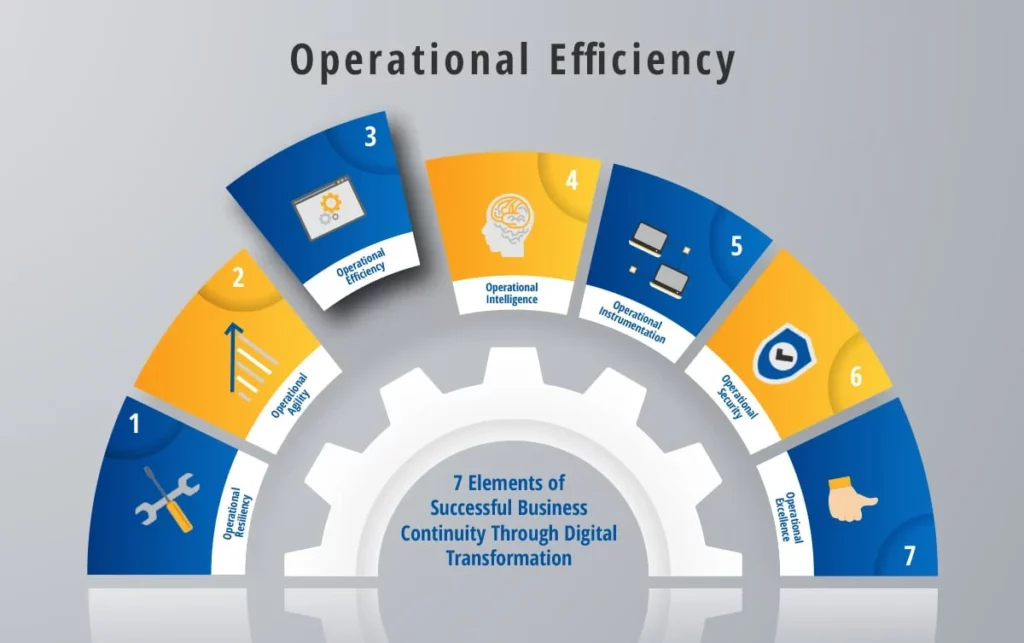
What is Operational Efficiency?
To begin with basics as to what is operational efficiency? Typically, operational efficiency is used to link a strong relationship between an organization’s both input and outputs in a healthy way. This efficiency helps the company and their businesses to cut off the extra expenses to their minimum level while increasing its revenue. It\’s what companies aim for: to successfully deliver a high-quality product like employee monitoring software on a large scale while using the fewest resources.
The operations manager should be capable enough to detect all the unnecessary procedures, this technique helps in saving needless expenditures. Moreover, to do so, the managers must be able to establish a baseline for their operations.
Difference Between Productivity and Efficiency
Both terms, “productivity\” and “efficiency” are frequently used interchangeably, however, they are two different terms and cannot be used interchangeably. The definition according to Michael Mankins of the Harvard Business Review is quite simple, Typically, the term operational efficiency is all about doing the same thing (operations) with less (minimum expense), whereas productivity is about doing more with the same.
Typically, enhancing productivity needs intensive investigation of the present resources. This helps in improving the performance. Since different company sizes include different targets, hence, there is no one size fits all strategy when it comes to increasing efficiency.
Boosting the recruiting firm’s productivity means improving the performance of their recruiters. Similarly, one can easily imply boosting machine production for a manufacturing organization. Or for a physical store, this would imply increasing sales/sq. ft.
When a company is on a goal to boost production then operational efficiency managers from all the available resources should figure out how to get the most out of them. This also covers the additional amount a company can spend on training or maintenance. The expenditure is justifiable in this scenario Since the production has grown in this scenario the cost is quite justified.
The goal of operational efficiency is to produce at an equal level while utilizing fewer resources. So, if we continue with our manufacturing example then we realize that the company is on a target to increase the production of produced products on the same number of manufacturing machines.
What to Priorities: Productivity Or Efficiency?
We all know that placing the cart before the horse is a recipe for disaster. The terms efficiency and productivity are interchangeable. If you want to increase your company\’s total performance, you\’ll want to boost both, but efficiency comes first. As a result, the amount of wasted work and resources on the company\’s side will be reduced. After efficiency has been enhanced, the company may focus on increasing productivity.
Efforts to boost productivity will be more productive with this strategy since it is founded on a foundation of super-efficient operations.
How One Can Establish a Baseline of Operations:
Within an organization, a baseline of operations specifies the functions that enable the organization to perform properly. You may accomplish this by speaking with key stakeholders in the company while inquiring about how each department can collaborate to assist the company in achieving its objectives.
In enterprises, each department might operate independently. Whereas when talking about smaller organizations there is a high chance of overlapping roles and responsibilities.
You Might Include These Questions:
- What is the key function of your company’s department?
- What role does this department play in helping the organization to achieve its goals?
- What are the department\’s primary responsibilities?
- What efforts are being done to fulfill these responsibilities?
The main objective is to be able to comprehend the primary functions that each department undertakes to fulfill its responsibilities.
Measurement and Improvement of Operational Efficiency
Divide output (sales, inbound leads, revenue, cold calls, etc.) by the given input to assess operational efficiency (such as man-hours, resources, licenses, etc). Since, efficiency, as defined by Mankins in the Harvard Business Review, is the ability to provide the exact product with less input.
Decision-makers must first establish which output and input variables are best suited for their company before calculating efficiency. Key performance indicators, or quantitative measurements that represent an organization\’s health, define these factors (dictionary). These can provide neutral statistics regarding performance, which can give insight into an organization\’s overall direction.
Phase 1: Make a note of your performance and compare it to industry norms. This will serve as a benchmark against which the company may assess progress.
Phase 2: Examine the current state of operations and determine the functions and objectives of each department accordingly.
Phase 3: When it comes to implementing those functions and objectives, you need to know the key actors and what their main purpose is.
Phase 4: The next phase is to assess the amount of time it requires to attain those objectives as well as the quality of work produced in each step.
Phase 5: Identify bottlenecks in each phase that slow down the process. Any functions or processes that aren\’t required to complete the task at hand are considered bottlenecks. For instance, a bottleneck would be waiting a few days for additional approval when two approvals are enough.
Phase 6: Get rid of the bottlenecks. The 5S approach (Sort, Shine, Straighten, Standardize, and Sustain) is one way to reduce waste. To obtain the best results, the leadership team must work together with other staff members.
Phase 7: Track improvements by measuring the current performance level and also comparing it to the prior operational baseline. Ensure that the quality of the job is not harmed along your way.
Phase 8: Create a dashboard or reports or track results. Regularly meet with your team to discuss performance and opportunities for growth.

